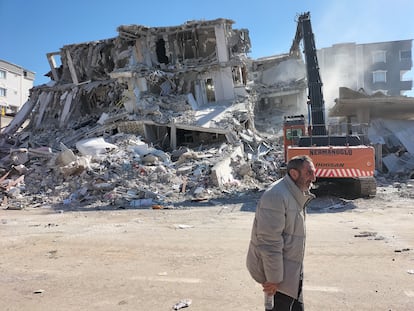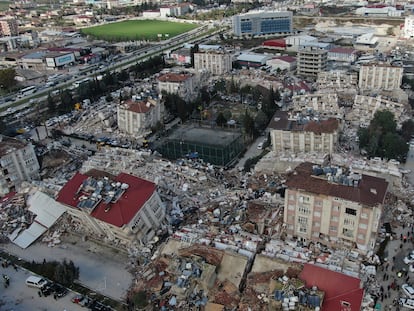How a ‘piece of paradise’ turned into a grave: the collapse of a luxury building in Antakya
One of the most exclusive buildings in this historic Turkish city, a tower of 249 apartments that boasted of the ‘highest construction standards,’ collapsed in the quakes. Nearly 1,000 people remain under the rubble


The real estate development was advertised as “a piece of paradise,” a building made to “the highest construction standards.” Today it is a pile of rubble. The Rönesans (Renaissance) tower was, until Monday, one of the most exclusive vertical developments in the center of Antakya, a 12-story block covering 10,500 square meters. It had 249 apartments with between two and five bedrooms each, a swimming pool, sports courts , receptionists... An estimated 1,000 people lived in it. Most are still trapped under the rubble of an earthquake that has already left more than 22,000 dead.
One of the missing is Sevtap Karaabdüloglu, a teacher originally from Van, a city in the southeast of Turkey. “She chose that apartment building very consciously because she knew what an earthquake was. She had suffered it in Van in 2011, and had to live for months in a camp of prefabs. So when she came to Antakya, after living in a teachers’ residence for a year, she searched very carefully and chose Rönesans,” explains her friend and former university classmate Ece Yilmaz by phone from Istanbul. Her husband is in Antakya as a volunteer, trying to help with the rescue work.
Both, along with other friends and relatives of the victims, have established a Telegram channel to share information and ask for help. As in other places in the province of Hatay (in the south of the country), the emergency teams took more than a day and a half to arrive, although there are now rescuers there from the AKUT volunteer association and from Romania and Hungary. “Even though 72 hours have passed, there are still people alive. Voices can be heard from the rubble, but the equipment is insufficient. Please let’s share it on all platforms. Let’s get to the survivors before they stop breathing,” asked one of the members of the Telegram channel.
One of the difficulties in the rescue of people trapped in the Rönesans is that one of the facades collapsed on the rest, which makes it easier to access some of the first floors and rooms on the side of the collapsed facade, but difficult to access the other side, where the facade crushed the other floors. “It was a very violent collapse,” said a witness.
On Friday morning, a company provided a thermal measurement device that made it possible to verify that there are still survivors under the rubble, although their condition is critical.
- “Here is a group that is about to die,” explains one of the operators in a video recorded by one of the volunteers and shown to EL PAÍS.
- "His [body] temperature has dropped a lot," responds another.
- “There are three people. One is there, under the column,” says another rescuer.
- "How far?".
- "About 35 meters from me."
The low nighttime temperatures together with the lack of food and water, and the injuries, make it difficult to survive three days after the earthquake. In some cases, rescuers have removed the bodies of people who, despite having survived the collapse of the buildings, died of hypothermia. “They have pulled several people out alive. But we still haven’t heard from Sevtap or her sister, Mehtap. As time goes by our hopes weaken, but we still want to keep thinking that they are alive,” Yilmaz recounts through tears.
Theoretically, and according to the financial newspaper Dünya, the Rönesans apartments were built on a floating foundation, which better withstands seismic activity and is used on land with little bearing capacity. Construction began in 2012 and was completed in 2013, so it was required to include all the anti-seismic measures required by law. Precisely for this reason, in addition to its facilities and its location, it was a typical choice among people who came from outside the province to work for a few months or years in Antakya – typically teachers, engineers or even soccer players. The Ghanaian midfielder Christian Atsu, who played for Málaga and Chelsea and now wears the Hataysport shirt, was one of the residents. He is also one of the missing.
Amnesties
There are more examples of buildings built as recently as 2018 and 2019 that have also collapsed in the same Hatay province where Antakya is located, and also in other regions of Turkey. In an interview with the BBC, the president in Istanbul of the Union of Chambers of Engineers and Urban Planners, Pelin Pinar Giritlioglu, estimated that up to 75,000 buildings in the area affected by the earthquake have received “amnesties.” That is to say, that, in exchange for a fine, they are allowed to continue standing despite the fact that inspections have decreed that they do not comply with the construction or anti-seismic protection standards required by law. Even the Ministry of City Planning itself recognized in 2018 that half of the buildings in Turkey do not comply with the regulations. But these amnesties continue to be granted, especially in pre-election periods. In fact, the Turkish president, Recep Tayyip Erdogan, had announced one ahead of the elections next May.
The builders of Rönesans, the brothers Mehmet Yaşar Coşkun and Hüseyin Yalçın Coşkun, are also missing. But not under the rubble. The webpages and telephones linked to their offices have been disconnected, as EL PAÍS was able to verify. A former partner, an architect, explained to that he does not know their whereabouts and that their last job he is aware of was a business promoting investment and obtaining citizenship in Montenegro, with offices in Istanbul. A former accountant for the company told the Turkish outlet ArtiGerçek that the last time she spoke with Hüseyin Yalçin Coskun, he was in Montenegro. Since the earthquake, no one has been able to contact him.
Sign up for our weekly newsletter to get more English-language news coverage from EL PAÍS USA Edition
Tu suscripción se está usando en otro dispositivo
¿Quieres añadir otro usuario a tu suscripción?
Si continúas leyendo en este dispositivo, no se podrá leer en el otro.
FlechaTu suscripción se está usando en otro dispositivo y solo puedes acceder a EL PAÍS desde un dispositivo a la vez.
Si quieres compartir tu cuenta, cambia tu suscripción a la modalidad Premium, así podrás añadir otro usuario. Cada uno accederá con su propia cuenta de email, lo que os permitirá personalizar vuestra experiencia en EL PAÍS.
¿Tienes una suscripción de empresa? Accede aquí para contratar más cuentas.
En el caso de no saber quién está usando tu cuenta, te recomendamos cambiar tu contraseña aquí.
Si decides continuar compartiendo tu cuenta, este mensaje se mostrará en tu dispositivo y en el de la otra persona que está usando tu cuenta de forma indefinida, afectando a tu experiencia de lectura. Puedes consultar aquí los términos y condiciones de la suscripción digital.
More information
Últimas noticias
Most viewed
- Oona Chaplin: ‘I told James Cameron that I was living in a treehouse and starting a permaculture project with a friend’
- Sinaloa Cartel war is taking its toll on Los Chapitos
- Reinhard Genzel, Nobel laureate in physics: ‘One-minute videos will never give you the truth’
- Why the price of coffee has skyrocketed: from Brazilian plantations to specialty coffee houses
- Silver prices are going crazy: This is what’s fueling the rally











































